
| 29 Apr, 2021 |
| Honda
Civic Mk11 |
 The 11th generation Honda Civic has been unveiled in production form. Although its styling was already previewed by the prototype a few months back, it is still a disappointment to see a face so conservative. While the outgoing Civic had a sportscar-like nose, the new one gets an upright nose and a horizontal bonnet, resulting in a less wind-cheating shape. Honda abandons the cab-foward design of the old car, pushing the base of its A-pillars back by 50mm. It thinks this look like a premium car, but I guess no one would confuse it with a rear-drive machine. On the contrary, the more upright windscreen makes the Mk11 more boring. Its details are more refined, unquestioably, but the shape hardly stands out. The new car is slightly longer than before, and its wheelbase is stretched by 36mm, but width and height are kept unchanged. The chassis gets 8 percent boost in torsional rigidity. The front subframe has been converted to aluminum and made more rigid as well. Suspension layout remains unchanged: MacPherson struts up front and multilink setup at the back. However, there are plenty of improvements in the details. The front suspension gets low-friction ball joints and damper mounting bearings to improve steering feel. The rear suspension gets wider track to improve roadholding and larger bushings to cut NVH. 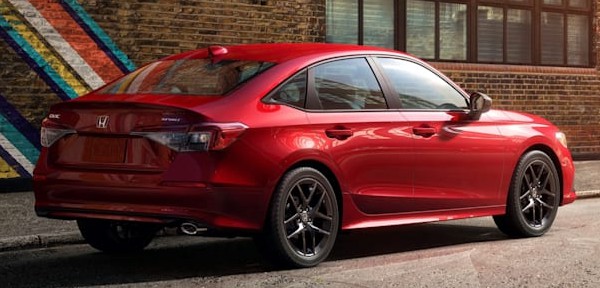 Less changes are the engines. Both the 2.0-liter i-VTEC and 1.5-liter Turbo units return. The former is virtually unchanged, with output standing at 158hp and 138 lbft. The 1.5 Turbo used to employ only variable cam-phasing but now it adds VTEC variable valve timing and lift to the exhaust side. In additional to improve turbo plumbing, output is lifted from 174hp and 162 lbft to 180hp and 177 lbft. Both engines mate with a CVT. However, don't expect the 1.5T to be much quicker, as the new car gains about 50kg.  The biggest improvement is probably the interior, which is simpler and higher in build quality. Unusually, a single piece of mesh accent runs the full width of the dashboard, covering the vents, so you adjust the vents using joysticks. The instrument is now a combination of mechanical dial and 7-inch LCD, while top-spec model employs a 10.2-inch full LCD. As for infotainment system, you get either a 7-inch or 9-inch touchscreen, both incorporate hard buttons and a rotary volume knob for easier access. Likewise, Honda keeps the rotary controls and physical buttons for climate control. New steering wheel and more comfortable front seats should improve driving comfort, as is more shoulder and hip room at the back seat. The Mk11 Civic sedan continues to be built in Canada, but hatchback model will shift from UK to USA as the former plant is closed. Therefore, the upcoming Type R will be built in the US for the first time. |
| |
| 16 Apr, 2021 |
| Mercedes
EQS |
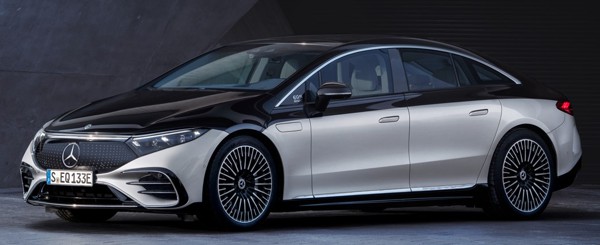 Mercedes' first vehicle built on a dedicated EV platform is the EQS. As suggested by its name, this is the equivalent of an S-class in the growing EV line-up of Mercedes Benz. It should be priced to match the S-class, although I suspect the latter might be more spacious. The EQS is actually slightly longer than the S-class in standard wheelbase. It measures 5216mm long, 1926mm wide and 1512mm tall, and runs a superior, 3210mm wheelbase. However, since it rides on a skateboard platform, with the battery stalled underneath the cabin, in addition to a swoopy roof line, expect it hard to match the S-class for head room. 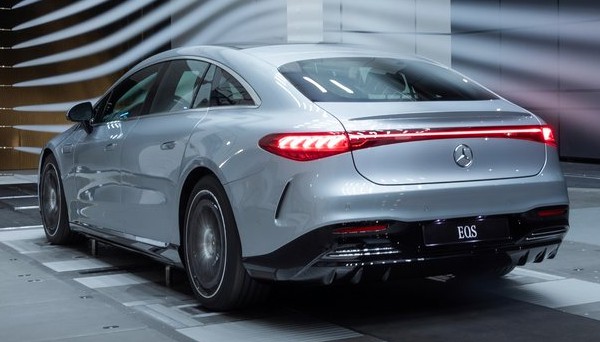 The styling of EQS is somewhat controversial to me, as it seems to be totally different from the tradition of Mercedes. This is a cab-foward and monospace shape, with very fast angle A and C-pillars and sweeping waistline. In addition to the use of frameless windows, you might wonder what chances left to the CLS-class in the future (yes, that model might be axed). Instead of traditional radiator grille, the nose features a black panel which extends seamlessly to both headlamps. The very slippery shape achieves a record-breaking drag coefficient of 0.20, bettering the 0.22 record currently held by the S-class and A-class sedan. Reduced panel gaps (the bonnet is fixed), underbody panelling, drag-optimized wheels and flush door panels (pop out remotely) make some contributions. 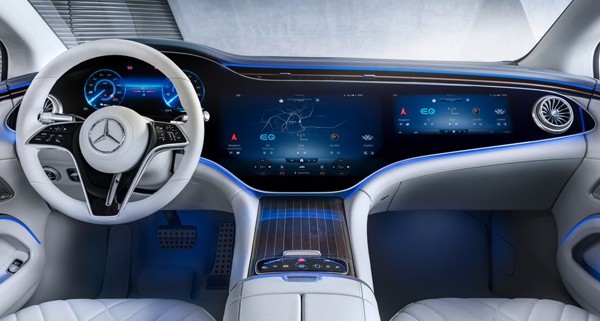 Inside, it is equally controversial. The big news is the optional MBUX Hyperscreen, which has the entire dashboard covered with a single glass panel, under which there are 3 large screens: a 12.3-inch TFT instrument, a 12.3-inch touch screen for the passenger and a 17.7-inch central touch screen. Predictably, you can expect the same clever functions offered by the S-class, such as voice/gesture control, AR HUD, 3D instrument display and active LED ambient lighting. However, if you don't opt for Hyperscreen, the dashboard design will be much closer to the S-class, with a 12.8-inch portrait floating touchscreen dominating the center console and a free-standing TFT instrument screen. Material-wise, it still looks luxurious enough, but not up to the level of S-class. 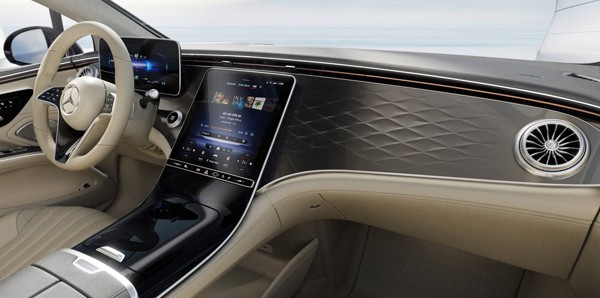 In the technical side, the EQS does not break any new grounds in the world of EV. It follows the norm set by Tesla, with all batteries placed inside the floorpan with protective casing. 2 battery sizes are offered: 90kWh or 108kWh net capacity. There are 2 electric powertrains to opt for: EQS450 gets only a rear motor with 333hp / 419 lbft, good for 131 mph and 0-60 in 5.9 seconds; EQS580 4matic employs 2 motors with 523hp / 630 lbft, capped at also 131 mph but runs 0-60 in merely 4.1 seconds. When the less powerful model is equipped with the larger battery, the maximum driving range is 770 km (478 miles) measured under WLTP cycles. Charging can be done with 200kW quick charger. 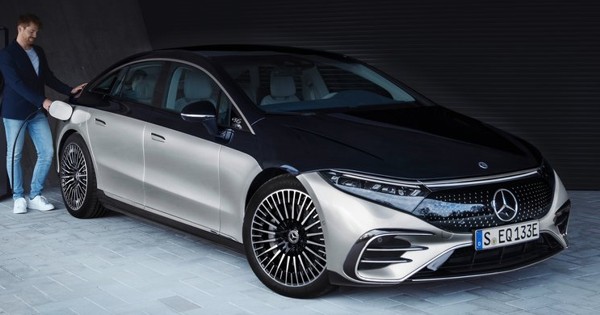 Predictably, this car is as heavy as a Rolls-Royce Phantom: EQS450 at 2480kg and EQS at 2585kg. However, since they have low center of gravity, in addition to air suspension, adaptive damping and standard 4WS, ride and handling should be remarkable for its class. As for refinement, the frameless windows might be a problem, but Mercedes equips it with acoustic glass and a lot of sound insulation foams around the cabin. |
| |
| 16 Apr, 2021 |
| VW Arteon R |
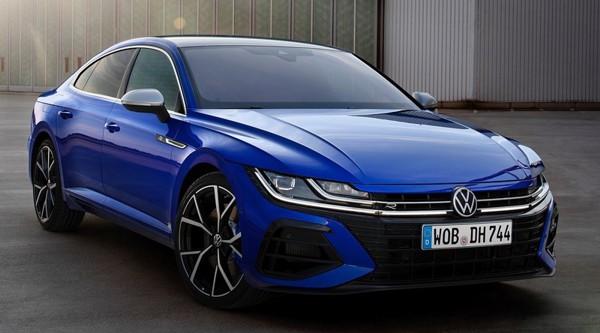 Volkswagen Arteon is also getting the same mechanicals that make the latest Golf R so good. This include the same EA888 engine with 320hp and 310 lbft output, standard 4motion with rear axle torque vectoring and 7-speed DSG box, as well as larger brakes, up to 245/35R20 tires and 10mm lower suspension with standard DCC adaptive damping. The car is good for up to 168 mph and 0-60 mph in 4.7 seconds. |
| |
| 6 Apr, 2021 |
| Toyota GR
86 |
 The Toyota version of Subaru BRZ has been unveiled in Japan. It is renamed to GR 86 to make use of the new Gazoo Racing performance brand. Apart from front end styling, it is virtually identical to the Subaru, and very close to the last car as well, as they are derived from the existing platform with exterior dimensions practically unchanged. This means they will continue to be sold at affordable prices and keep the agile, entertaining handling that made the first generation so remarkable.  As in the case of BRZ, the biggest improvement of GR 86 has to be engine. The Subaru-supplied 2.4-liter boxer four produces considerably more power and especially torque than the old 2.0-liter unit. Output is lifted from 205 to 235 hp (DIN), still released at 7000 rpm. Maximum torque is now 184 lbft from 3700 rpm, way more useful than the old engine's 151 lbft at 6400 rpm. As the new engine employs oversquared combustion chambers (94 x 86mm vs the old 86 x 86mm), it is still capable to rev to 7400 rpm. The boxer motor mates with 6-speed manual or optional 6-speed automatic. The manual car claims 0-60 mph in 6 seconds flat, a full second quicker than the old.  Not much improvement can be seen in the interior. It remains to be basic and cost saving in the first concern, although infotainment system and digital instrument are updated. The chassis gains 50 percent in torsional rigidity thanks to reinforcement in subframes and suspension mountings, yet the car is no heavier at 1270kg (JDM figure). The roof is now made of aluminum to save weight and lower center of gravity. Suspension of the old car remains, consisting of MacPherson struts up front and double-wishbone at the rear, still without adaptive dampers. Despite greater power and torque to handle, it keeps using modest tire size of 215/40R18, although the wheels are an inch larger and new Michelin Pilot Sport 4S should improve grip. Expect power slide continiues to be its greatest asset. |
| |
| 1 Apr, 2021 |
| VLF
declares war against electrification |
 Law makers and car makers are turning to electric cars. Think the automotive world will get boring? Will tuners like Hennessey, Shelby American and Novitec face extinction? Ex-GM executive Bob Lutz disagrees. On the contrary, he thinks the popularity of electric cars could create huge business potential for his company, VLF Automotive, which has track records for converting electric Fisker Karma into the V8-powered Destino (pictured). The same can be done to fulfill the desire of tenths of millions of petrolheads worldwide. According to the plan Lutz revealed exclusively to AutoZine, VLF will launch a string of petrol cars converted from new electric cars. “At first, we’ll convert a Tesla P100D into one very exciting… how about a Chevy V8 completed with twin-turbo and really exciting noise?” “By using Tesla as basis, we are declaring war to electric car companies! Let the enthusiasts choose the way to go!" “What’s most promising is,” said an excited Lutz, “as the world has more and more new electric cars on offer, we are going to have more and more options and possibilities…” “Sorry about the demise of Blackwing V8? We are buying its patents and will install it into the new Hummer!” “Whatever Mercedes EQ arrives in the future, we will put an AMG V8 back into their engine bays. Frankly, I don’t understand why they design the engine bays so big, a perfect match for a big V8.” “Porsche should not have built the Taycan as an electric car. We are going to right the wrongs, putting a GT3 flat-six under the bonnet… and couple to manual gearbox! That will be a real Porsche.” We had a look into the list and got impressed, such as: - Volkswagen ID.3 with EA888 engine mounted at the tail and driving the rear wheels. VLF calls it “The truly New People’s Car”. - BMW i3 with the twin-cylinder Motorrad engine driving the rear wheels, stripped of battery to achieve 750kg kerb weight. Co-developed with Gordon Murray. - Audi E-tron GT powered by the R8’s V10, renamed Audi P-trol GT. A variant called D-sel GT will join later on. - Polestar 2 running an 8.4-liter Viper V10 and still weighs 400kg less than the original car - "M3 beater": Tesla Model 3 with 808hp Chrysler Demon V8 and drag race tires And the last one reads “Ferrari XX with V12”. We ask him what it means. “This is only plan B. If Ferrari really turns to electric, we’ll put its finest V12 back into the car, just to say Shame on You!” “Hopefully this will stop Maranello from doing silly things.” But what if the United States really ban ICE cars? “Don’t worry”, laughed out loud Lutz, “I maintain my forecast that Tesla will go burst in a few months. OTA function gets hacked and Autopiloted cars crash into one another. No one recycles million tons of batteries and everywhere is catching fire, underground water polluted by heavy metals… then our government will realize how wrong going all-electric could be. Hopefully by then Donald Trump will be our president again.” If this really comes true, then the prospect of automotive world will be very bright indeed. P.S. No, this is absolutely not an April Fool's joke. AutoZine can confirm that it is about as true as Volkswagen America declaring its plan to rebrand as "Voltswagen" not an April Fool's joke. |
| |
